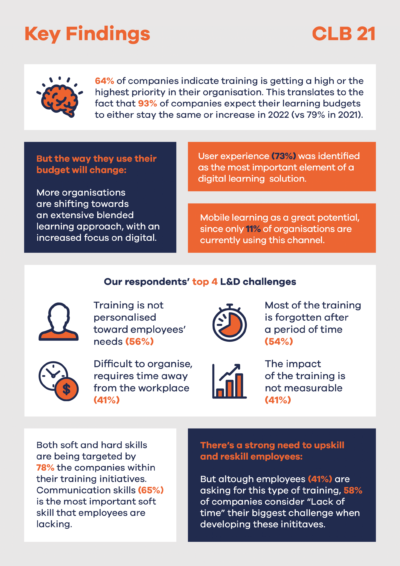Corporate Priorities Shift Towards Digital Training

Training: Among the highest of priorities
It seems that organisations are buckling up, and preparing to train their workforce extensively as means of adapting to new work environments. In fact, 64% of companies indicate training is either number one priority or up there with the most precedent issues in the organisation, slowly but surely making its way to the top. This is reflected in the fact that 93% of companies expect their learning budgets to increase, or at the very least stay the same for 2022, an impressive increase from 79% in 2021.
In order to continue to function effectively and productively, a shift in priorities and methodologies has become imperative. We find ourselves in the midst of a transformation that impetuously calls for the upskill and reskill of employees. Particularly with the capacity and ability to work remotely becoming a necessity.
Digital training is the way to go, but it still has a long way to go

Although last year there was also a general consensus regarding the allocation of larger budgets towards training, there is a notable difference in the manner in which these training budgets are being projected today. Unsurprisingly, we are witnessing a rise in the number of organisations that actively seek out a blended learning approach, focusing specifically on digital learning.
78% of organisations that are not currently making use of digital training, and 68% of organisations that are indeed already training their employees digitally, agree that they are considering adopting another digital training tool in the following year.
It makes sense for training to be digital when work environments, and work itself, is increasingly digital too. Moreover, digital training allows for the adoption of multiple tools to cater to different target groups and needs, which, as shown by the 68% of organisations that already use digital training yet are willing to consider new ones, is necessary.
The possibilities of corporate digital training
Digital training offers the possibility of tackling several issues encountered in traditional training in the corporate world. Traditional training can at times come across as stale, failing to properly engage with the individual needs and desires of each employee. On the other hand, digital training can provide customised and personalised solutions.
51,4% of organisations agree that in order for a digital learning application to truly make a difference, it should include an intuitive design and layout. Yet another thing to consider is the way in which the information is presented, with 37,8% of organisations believing that pieces of content should be short and bite-sized. Yet another key element of a learning application is the centralisation of all training in one place, with 37,8% of organisations stating that they wish to access all types of trainings (F2F, e-learning, etc) in the same place.
One thing’s for sure, if we wish to truly exploit the potential of digital learning and adequately train a new-age workforce, we need to ensure that digital learning tools can cater to different target groups, as means of eventually being truly effective and covering the needs of the company.

